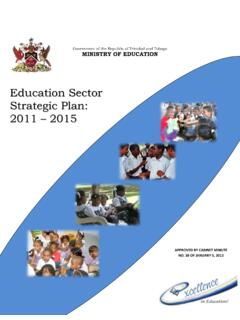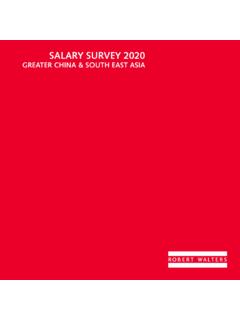Transcription of Philippine Education For All 2015: Implementation and ...
1 PPhhiilliippppiinnee EEdduuccaattiioonn FFoorr AAllll 22001155:: IImmpplleemmeennttaattiioonn aanndd CChhaalllleennggeess 2 I. General Introduction 1. Filipinos have deep regard to for Education . Education occupies a central place in Philippine political, economic social and cultural life. It has always been strongly viewed as a pillar of national development and a primary avenue for social and economic mobility. 2. A clear evidence of the value placed on Education is the proportion of the national government budget going to the sector. The Department of Education (DepEd), the country s biggest bureaucracy1, is given the highest budget allocation among government agencies each year as required by the 1987 Philippine 3.
2 The 1987 Constitution likewise guarantees the right to Education of every Filipino. It provided that, The State shall protect and promote the right of all citizens to quality Education at all levels and shall take appropriate steps to make Education accessible to all.. 4. The right of every Filipino to quality basic Education is further emphasized in Republic Act 9155 or the Governance of Basic Education Act of 2001. Along with Republic Act 6655 or the Free Secondary Education Act, these laws reaffirm the policy of the State to protect and promote the rights of all Filipinos by providing children free and compulsory Education in the elementary and high school level.
3 This pertains to six years of free tuition fees for children aged 6 to 11, and free four years of secondary schooling for those aged 12 to 15. 5. Along with Education for All , the Philippines is also committed to pursue eight time-bound and specific targets under the Millennium Declaration which it signed on September 2000. The Declaration, in general, aims to reduce poverty by half in 2015 ( percent proportion of the population below poverty incidence and percent below subsistence incidence by 2015). With the adoption of the Declaration, the Philippines likewise affirmed its commitment to the Millennium Development Goals (MDG) geared towards reducing poverty, hunger, diseases, illiteracy, environmental degradation and discrimination against women.
4 These goals have been mainstreamed in the country s Medium Term Philippine Development Plan (MTPDP) 2004-2010 including policies and plans related to children, access to primary Education and gender equality. Specifically, Part IV of the MTPDP focused on Education and Youth Opportunity. 6. However, despite the legal mechanisms, budget prioritization and increased access, Philippine Education has been dogged with issues. Among the issues that needs to be resolved but have improved lately include the high dropout rates, high number of repeaters, low passing grades, lack of particular language skills, failure to adequately respond and address the needs of people with special needs, overcrowded classrooms and poor teacher performances.
5 These problems in turn resulted to a considerable number of illiterate Filipinos and out of school youths and graduates who are not prepared for work. 1 Allocation for basic Education averages 85 percent of the total Education budget according to an unpublished UN Country Report in 2008. 2 Article XIV, Sec. 5, paragraph 5 of the Philippine Constitution. 3A. Philippine Education Structure 7. The Philippine Education system includes both formal and non-formal Education . The formal Education is a sequential progression of academic schooling at three levels: elementary (grade school), secondary (high school) and tertiary (college and graduate levels).
6 By structure, Philippine Education is categorized either as basic (preschool, elementary and high school) or tertiary (college, graduate and technical/vocational). 8. Basic Education pertains to optional preschool at age 3 to 5, then six years of elementary schooling for aged 6 to 11, and four years of secondary schooling for aged 12 to 15. Excluding early childhood care and development (ECCD) or preschool, Philippine formal basic Education subsystem is one of the shortest in the Asia Pacific with just 10 years of basic schooling compared with 11 to 12 years in other countries. 9. Basic Education is being handled by the DepEd while college is under the Commission on Higher Education (CHED) and vocational/technical and non-degree training under the Technical Education and Skills Development Authority (TESDA), which is under the Department of Labor and Employment (DOLE).
7 TESDA runs a variety of skills development centers throughout the country. Although being overseen by CHED, local colleges, however, are being operated by local governments as indicated in the local government code. 10. DepEd also handles the alternative learning system (ALS) for out-of-school youths and adults through its Bureau of Alternative learning System (formerly Bureau of Non-formal Education ). Islamic educational institutions or Madaris (plural of Madrasah) are also under the jurisdiction of DepEd, although most operate independently of each other and exist without passing through the standardization process.
8 Most madaris are privately-owned and rely on the support of the local community or donors. B. Overview on EFA 11. In 1990, there was a World Declaration on Education for All (EFA) in Jomtiem, thailand , which prescribed that Basic learning Needs shall be met for all by various means. As a response, the Philippines crafted and implemented the 10-year EFA Philippine Plan of Action covering 1991-2000. The EFA plan articulated the country s national goals, objectives, policies and strategies, as well as the regional programs for Implementation for the first decade of the EFA movement. Under the 1991-2000 Plan (EFA 1), the thrusts included: Early Childhood Development Expansion of self-sustaining community-based ECCD Use of innovative approaches to parent Education Promotion of preparatory Education Accreditation of private pre-school programs and institutions Differentiated approaches for special categories of children Strengthening of health, nutrition and other allied services Socio-cultural adaptation of curriculum.
9 Materials and approaches Single agency to coordinate programs for ECCD 4 Universalization of Quality Primary Education Enhancing the holding power or student retention of schools Using alternative teaching- learning delivery modes Strengthening home-school partnership Emphasis on higher-level thinking skills Upgrading teacher competencies Alternative learning Systems Eradication of illiteracy in selected areas Promotion of continuing Education and development Implementation of integrated programs 12. In 2000, the Philippines, as a reaffirmation of the vision set in the 1990 World Declaration, committed itself to the following EFA 2015 Goals at the World Education Forum in Dakar: Goal 1: Expand and improve comprehensive early childhood care and Education , especially for the most vulnerable and disadvantaged children; Goal 2: Ensure that by 2015, all children, particularly girls, children in difficult circumstances and those belonging to ethnic minorities, have access to complete free and compulsory primary Education of good quality.
10 Goal 3: Ensure that the learning needs of all young people and adults are met through equitable access to appropriate learning and life skills programs; Goal 4: Achieve a 50 percent improvement in levels of adult literacy by 2105, especially for women and equitable access to basic and continuing Education for all adults; Goal 5: Eliminate gender disparities in primary and secondary Education by 2015, with focus on ensuring girls full and equal access to and achievement in basic Education of good quality; and Goal 6: Improve every aspect of the quality of Education , and ensure their excellence so that recognized and measurable learning outcomes are achieved by all, especially in literacy, numeracy and essential life skills.







